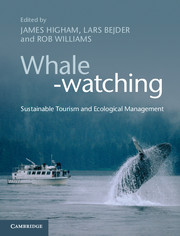Book contents
- Frontmatter
- Dedication
- Contents
- Acknowledgements
- List of contributors
- List of abbreviations
- 1 Tourism, cetaceans and sustainable development
- Part I The historical and contemporary contexts
- Part II Human dimensions of whale-watching
- Part III Ecological dimensions of whale-watching
- 13 Understanding the ecological effects of whale-watching on cetaceans
- 14 Whale-watching and behavioural ecology
- 15 Energetic linkages between short-term and long-term effects of whale-watching disturbance on cetaceans
- 16 Ecological constraints and the propensity for population consequences of whale-watching disturbances
- 17 The use of area–time closures as a tool to manage cetacean-watch tourism
- Part IV Sustainable management: insights and issues
- Index
- Plate Section
- References
17 - The use of area–time closures as a tool to manage cetacean-watch tourism
from Part III - Ecological dimensions of whale-watching
Published online by Cambridge University Press: 05 April 2014
- Frontmatter
- Dedication
- Contents
- Acknowledgements
- List of contributors
- List of abbreviations
- 1 Tourism, cetaceans and sustainable development
- Part I The historical and contemporary contexts
- Part II Human dimensions of whale-watching
- Part III Ecological dimensions of whale-watching
- 13 Understanding the ecological effects of whale-watching on cetaceans
- 14 Whale-watching and behavioural ecology
- 15 Energetic linkages between short-term and long-term effects of whale-watching disturbance on cetaceans
- 16 Ecological constraints and the propensity for population consequences of whale-watching disturbances
- 17 The use of area–time closures as a tool to manage cetacean-watch tourism
- Part IV Sustainable management: insights and issues
- Index
- Plate Section
- References
Summary
Introduction
The world's oceans have been exploited for generations. In some cases, this has led to the removal of top predators from ecosystems, resulting in a cascading effect through trophic levels altering ecosystems and restructuring food webs (Pauly et al., 2002; Myers & Worm, 2003). Cetaceans (whales, dolphins and porpoises) have also been targeted, mainly for their meat and oil, and some populations being driven close to extinction. Fortunately, attitudes towards cetaceans have changed over the past two decades, and rather than harvest them, it is now more desirable to observe them in their natural environment (Bearzi et al., 2010). Today, cetaceans are icons for marine conservation efforts. The USA was the first country to introduce legislation to protect marine mammals through the Marine Mammal Protection Act 1972 (MMPA). The MMPA was designed to minimize the capture or ‘take’, harassment and disturbance of marine mammals, primarily from fishing operations as by-catch and from cetacean hunting. The MMPA defines the term ‘take’ as ‘hunting, killing, capture and harassment of a marine mammal or the attempt thereof’. Since the declaration of the MMPA, other countries have adopted their own legislation, e.g. The Marine Mammals Protection Act 1978 in New Zealand and the Environment Protection and Biodiversity Conservation Act 1999 in Australia.
- Type
- Chapter
- Information
- Whale-watchingSustainable Tourism and Ecological Management, pp. 242 - 260Publisher: Cambridge University PressPrint publication year: 2014
References
- 10
- Cited by



